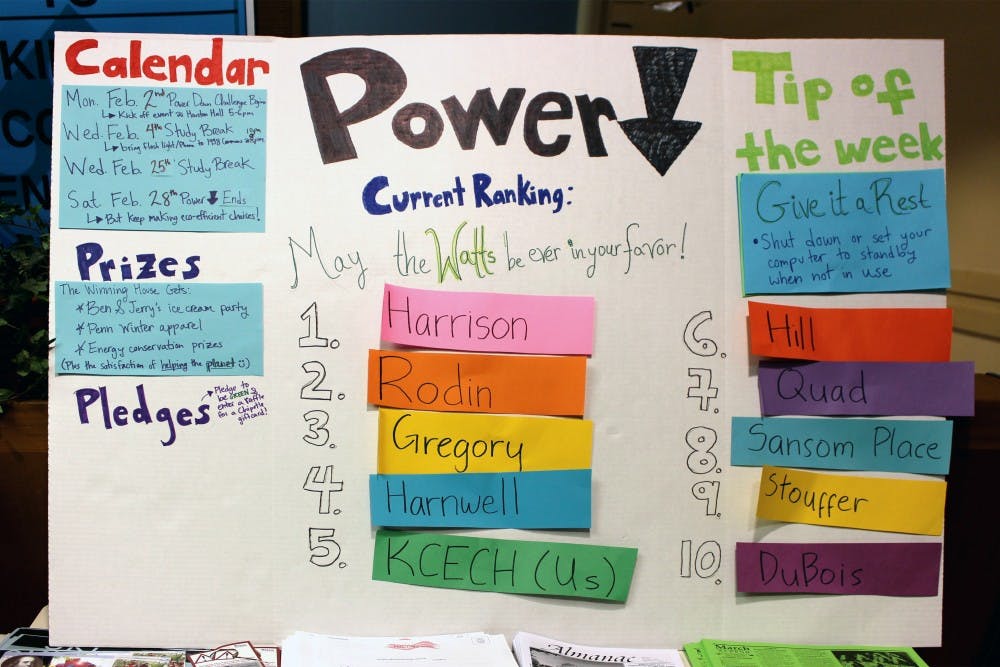
The Power Down Challenge tracked which College Houses were using the least energy during the challenge.
Credit: Ritika PhilipIt may be disheartening for some students to see that their power down efforts yielded a null result — but Penn recognizes that progress was made toward raising awareness and promoting sustainability.
The results of the 2015 Power Down Challenge held in February show that less than half of the college houses reduced electricity usage throughout the course of the challenge. Facilities and Real Estate Services emphasized however, that the real objective of the Power Down Challenge is not to achieve improved electrical efficiency results, but to heighten student awareness and involvement in the ongoing project of sustainability at Penn.
“It’s really easy to get caught up on the competition piece of the challenge,” Sustainability Associate Julian Goresko said, “but really, in the end, the goal for us is to teach energy conservation habits and to empower students who are passionate about environmental issues.”
“I think it’s frustrating for students when there is a disconnect between the effort put forth and the result they see, but there’s a big success story too in the amount of student effort,” Goresko said. Eco-Reps in each college house coordinated special power-down events including handing out energy efficient light bulbs and holding pancake brunches and house parties without the lights on. “What we want to see is students getting creative,” Executive Director of Operations Ken Ogawa added, “and that’s exactly what we saw.”
This particularly cold February did not help the move to power down. The average temperature for February 2015 was approximately 10 degrees lower than that for January 2015. “We use a two week baseline in order to get a representative average of the season’s temperature,” Goresko said.
“Weather definitely plays an important factor,” Goresko added. “We know from survey data that when it is colder, students definitely stay inside more, of course. When trapped inside by a February snowstorm, it can be challenging to avoid using the lights or the microwave.”
“There are a lot of things in a building that use electricity which many people are unaware of,” Ogawa said. “Something as simple as taking a shower in the high rises uses electricity, because hot water needs to be pumped to the upper floors.”
Although Penn’s heating is steam powered, the distribution of heat in the winter is dependent on electric fans and pumps. “There’s a lot of hidden factors that even we hadn’t thought of much before in past years,” Ogawa said.
Each year changes are made to the Power Down Challenge, which has expanded and evolved significantly since its inception. While it is uncertain what improvements will be made to the challenge for 2016, FRES expects the challenge to continue to evolve and adapt.
“Each year, we look at the data and learn a little bit more on how the buildings operate … behind what students merely see,” Ogawa said.
One big change in the Power Down Challenge’s setup has been the decision to hold it in February instead of November. “We initially moved the challenge to February because of the difficulty of finding a multi-week period in the year when students are on campus without a break,” Goresko said. Several weeks are needed for the challenge in order to market the challenge to students and to monitor a significant amount of time for energy conservation.
“We need time to spin up the challenge, because as soon as we get going, the challenge is over,” Ogawa said.
November was also problematic because of the effects of daylight saving time, and that the heating in many buildings may be turned on in November.
“We want to focus on things that are more than just a one-off solution to decreasing energy usage,” Ogawa said. Holding a hall party in the dark may reduce electricity consumption now, “but we are looking for ways to sustain that effort even as a new student body comes in,” he added.
“A lot of buildings did not see much of an increase in energy savings this year, because they kept much of the savings from previous years,” Ogawa said. The baseline energy usage for each year becomes less and less as efficiency and sustainability initiatives have their lasting effects.
“There is less room for improvement by means of changing behavior," he said, "especially as new technologies make buildings more energy efficient before any effort has been made."
The Daily Pennsylvanian is an independent, student-run newspaper. Please consider making a donation to support the coverage that shapes the University. Your generosity ensures a future of strong journalism at Penn.
DonatePlease note All comments are eligible for publication in The Daily Pennsylvanian.





